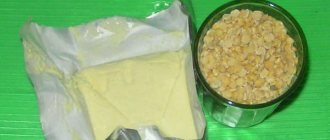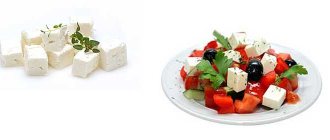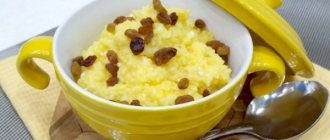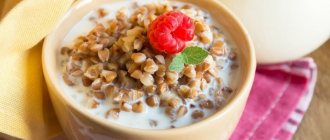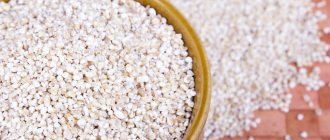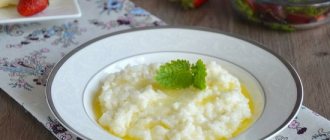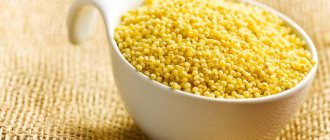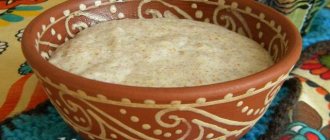Dietary properties:
How many calories are in pea porridge, what dietary properties it has, all this is of great interest to those who lead a healthy lifestyle and watch their figure. So we will try to answer these questions in the next article.
So here it is:
Porridges began to be cooked from peas back in ancient times in the cuisine of different nations. It was and remains a very inexpensive and useful product that everyone can afford. It is most popular among the Slavs.
Everyone probably knows that this herbaceous plant belongs to the legume family. This is not only a beautiful, but also a useful culture. Delicious porridges are prepared from its grains, which are rich in nutrients, vitamins and dietary fiber. Pea porridge is useful because it contains valuable vegetable protein and starch. It contains a lot of carbohydrates and natural sugars.
This dish is prepared by boiling shelled peas in water. As a rule, vegetable oil, various spices and seasonings are added to it.
In addition to a balanced amino acid composition with a considerable number of essential components, this porridge can boast of the presence of a natural antioxidant - vitamin E, which inhibits the aging process and has a beneficial effect on the skin. It contains vitamin A, which makes vision sharper, and ascorbic acid (vitamin C), which strengthens immune defense and helps prevent colds.
In addition, peas contain B vitamins, which are necessary for the health of the central nervous system and hematopoietic processes. Among the minerals, it should be noted calcium, which strengthens bone tissue, magnesium and potassium, necessary for the functioning of the heart, iron, without which the synthesis of red blood cells cannot take place.
For vegetarians and simply for people who prefer a healthy lifestyle, pea porridge is an essential and sometimes vital product that has enormous nutritional value due to its high vegetable protein content. In addition, legumes, and in particular peas, should be included in the diet of every person, regardless of gender, age and nationality, regardless of what kind of work - physical or mental - he is more occupied. This dish saturates our body with vital energy for productive work, improves brain functioning, speeds up reaction and adaptation to stressful situations. It is often included in the diet of athletes, as well as in the menu of fasting days.
How many calories are in pea porridge?
Agree, most likely, few people would prepare mashed peas. However, those who still do not know the recipe are missing out on a lot. Pea porridge is a real storehouse of useful components that help the body function normally. Moreover, this porridge is one of the first to be recommended for those who are on a diet or want to lose weight.
It can also be “prescribed” by doctors and nutritionists for people who have certain health problems, for example, low hemoglobin, constipation, skin or kidney problems, and decreased appetite. The calorie content of pea porridge per 100 grams is 90 calories, of which proteins – 6.7 grams, fats – 0.8 grams, carbohydrates – 17.7 grams.
However, this amount may vary depending on how it is prepared. Basically, porridge is cooked in water, so this indicator does not change in any way, but still, some people prefer to add salt and oil, while others don’t, and there is a huge difference between how much salt to add and what specific amount use oil.
Let's figure out what the calorie content will be for pea porridge cooked in water without oil, and for porridge with butter and salt. Ready-made boiled pea porridge with water contains 60 calories per 100 grams. This is a very low indicator, which is why this product is recommended for those who are on a diet.
And the norm for consumption of such a product will be 200-250 grams at lunchtime. If you eat more, you may experience flatulence and other minor side effects from peas.
Now that we have found out how many calories are in pea porridge with water, it is worth noting that the same amount of calories will remain in the porridge if you cook it without oil. Some people will find the porridge tasty if you don’t add anything to it, but still few people will want to voluntarily eat it, at least without salt.
By the way, how many calories will there be in pea porridge with water and without oil, but with salt? Only 74 calories per 100 grams! This means you can exclude oil, but you don’t have to give up salt. You can also use various spices, herbs and seasonings to give the porridge its own special taste. But do not forget that some seasonings may already contain salt, so before adding salt, make sure of this. This way, only seasoning can be used in cooking.
We found out the calorie content of pea porridge with water (per 100 grams), but then how many calories will there be in such porridge with sunflower oil? It all depends on how much oil you add. If it is just a couple of drops, then you will get 90 calories in 100 grams of porridge.
But when, in addition to sunflower oil, you also add butter, then the calorie content will increase to 135 calories. The consumption rate will remain the same - approximately 200-250 grams per meal. However, you should not use it more than once a week - unpleasant side effects may appear in the form of bloating, flatulence, and the like.
| Calorie content of porridge | Kcal |
| Without oil and salt | 60 kcal |
| With butter and salt | 110 kcal |
| With butter | 125 kcal |
| With salt | 74 kcal |
Pea porridge for weight loss:
In order for weight to naturally remain normal, proper metabolism is necessary. This dish is both natural and rich in useful elements, so it is quite suitable for harmonizing metabolism.
Fasting days with him are also a good idea. Eat a small portion of pea porridge for breakfast, lunch and dinner, and complement each meal with fresh vegetables and fruits. There is also a special pea diet. This diet is simple and well tolerated. The body receives everything it needs, you do not lose muscle mass, and you almost never feel hungry. One of your meals should include a pea dish. Soup, porridge, salad, side dish.
Vegetable pea proteins in this diet completely replace meat, and in between it is advisable to eat fresh fruits and berries. Breakfast can include muesli, yogurt or low-fat milk, and dinner can include a fresh vegetable salad. While following a diet, do not forget to drink more. Herbal or fruit teas and, of course, clean water are helpful.
What does pea porridge contain?
We have come to the most interesting part, namely, what is included in pea porridge, and why is it still so healthy? It really does contain a lot of vitamins and minerals, and you will find out which ones exactly below. First, let's look at the nutritional value of this product:
- proteins – 6.64 g (26% of the norm);
- fats – 0.59 g (5% of normal);
- carbohydrates – 17.7 g (68% of the norm).
The chemical composition includes:
- B vitamins (B1, B2, B5, B6, B9);
- vitamin E;
- vitamin H;
- vitamin K;
- vitamin A;
- calcium;
- magnesium;
- sodium;
- phosphorus;
- chlorine;
- iron;
- cobalt;
- manganese;
- copper;
- molybdenum;
- zinc.
More on the same topic:
4 comments
- LenaRU Writes, By the way, pea porridge also has contraindications. Peas contain quite a lot of so-called purines. These substances contribute to the accumulation of uric acid in the blood and the deposition of urates in the joints. Therefore, porridge with peas is not recommended for frequent consumption by older people and those who are prone to gout.
- Chef Writes,
You can cook not just pea porridge, but for example, pea porridge with buckwheat and potatoes. It works out very well! Potatoes with buckwheat are added to the boiling peas when they are half cooked. When all the ingredients of the porridge are cooked, add milk, salt, bring to a boil and grind into a homogeneous mass. You can also add onions fried in oil. - DonJ Writes,
Pea porridge? This is not for me. We also found food! - Red hair Writes,
Residents of our country are sure that peas appeared in Russia, after which all other nations learned about such a culture. However, we got peas from eastern countries. The benefits of pea porridge were known to the inhabitants of the Mediterranean. In the distant past, the ancestor of modern peas grew here.
How to cook pea porridge with meat
It’s not difficult to cook pea porridge, but it’s also easy to cook it in combination with other products. It turns out that you can mix it with potatoes or even buckwheat! We decided to collect for you the easiest to prepare, but also delicious recipes so that you can diversify your diet and always enjoy eating. Bon appetit!
Calorie content: 246 calories per 100 grams
Ingredients:
| Peas | 200 g |
| Meat (chicken, beef or pork) | 600 g |
| Carrot | 1 PC. |
| Onion | 1 PC. |
| Olive oil | 1 tbsp. l. |
| Spices | 1/5 tsp. |
Cooking process:
- Heat vegetable oil in a preheated frying pan and fry the meat, cut into pieces. Add carrots and onions, cut into pieces or grated, and fry until tender. At the end, add salt, pepper and spices.
- Boil peas, pre-soaked in water. You can salt and pepper the porridge to taste.
- When everything is ready, serve the porridge with fried meat, onions and carrots.
Healthy porridge with stewed vegetables
Compound:
- dry peas - 230 g;
- water - 500 ml;
- carrots - 2 pcs.;
- onions - 2 pcs.;
- sweet pepper - 2 pcs.;
- vegetable oil - 2 tbsp. l.;
- salt, ground black pepper.
Preparation:
Peas are a herbaceous plant that is part of the legume family. It is grown as a food or feed crop and is a pod containing pea seeds.
There are two main types for cultivation - sugar and peeling.
The first is used entirely for food along with the shell. And the second one is grown only for green peas, which are well suited for canning. Both sugar and shelled beans contain a lot of healthy protein, which is easier and faster to digest compared to meat, so it is very common in vegetarian cuisine. More often, peas are prepared as a side dish, but they are also added to baked goods, salads, first and second courses.
Counting calories
The calorie content and taste of mashed potatoes depend on the quantity, quality and type of added fat.
According to the recipe, the amount of animal fat should correspond to a ratio of 1:5.
Nutritional value of possible components (kcal per 100 g):
- potatoes – 80;
- butter – 748;
- melted – 887;
- margarine –746;
- vegetable oil – 899.
The calorie content of 100 g of mashed potatoes has the following characteristics (kcal):
- on water (without oil) – 80;
- with animal fats – 230-257;
- with vegetable oil – 260.
By reducing the amount of fat added to a dish, its calorie content decreases. Vegetable salads will improve the taste of a low-calorie product.
What are the benefits of pea porridge?
Pea porridge is a complete product that can replace meat products. This fact alone should be enough to convince you of the need to introduce this product into your diet. However, everyone wants to know what exactly porridge is good for, how it affects the body and whether it helps cure any diseases or prevent them. We have collected for you everything you need to know about the beneficial properties of this product and invite you to familiarize yourself with these indisputable facts below. Regular consumption of pea porridge promotes:
- improved vision due to vitamin A in the composition;
- reducing the risk of atherosclerosis;
- stabilization of the nervous system thanks to B vitamins;
- decreased blood sugar;
- improvement of depression, apathy, stress;
- removing toxins and waste from the body;
- stimulation of fat burning due to amino acids in the composition;
- strengthening the female body, including normalizing the condition during menopause or PMS;
- improvement of skin, hair, nails;
- slowing down the aging process;
- removing excess fluid from the body;
- reducing the risk of developing cancer;
- improving immunity;
- improving the functioning of the cardiovascular system.
As you can see, pea porridge really has a huge number of beneficial properties, which are given to it by the vitamins and minerals that make up its composition.
Moreover, this product not only can prevent cancer, infectious diseases and atherosclerosis. It also perfectly helps to improve the condition of frequent constipation, problems with appetite (accelerates metabolism) and kidney problems (even in difficult cases). In addition, many girls noted the beneficial effects of pea porridge on their skin.
Those who for a long time could not get rid of acne, rashes and other skin diseases, after regularly eating pea porridge, noticed that their skin problems went away. Porridge also does an excellent job of removing toxins and harmful waste from the body, which is considered a particularly serious problem in our time. And are you still wondering whether you should eat this porridge at least once a week?
Calorie content and benefits
Dry peas contain a lot of useful substances. The calorie content of porridge from this leguminous crop is 130 kilocalories. This is 23 calories less than wheat and 30 more than barley. Thus, among the available and popular porridges, pea porridge is in the middle. In addition to wheat, rice porridge is also high in calories - 144 kilocalories - and pearl barley with 138 kilocalories.
As for the content of vitamins and microelements, pea porridge boasts quite a large amount of vitamin A, B1, B2, PP and E. Dry peas also contain the following microelements: potassium, calcium, phosphorus, magnesium and sodium. The amount of iron in pea porridge is twice that of buckwheat.
Due to the large amount of potassium, pea puree is recommended for athletes and people who want to build muscle mass. Nutritionists advise including pea puree without oil in your menu as often as possible. The calorie content of one serving is within the normal range for a person leading an active lifestyle.
Polyunsaturated amino acids and antioxidants make this product indispensable in the fight to preserve beauty and youth. It’s no wonder that women in India and Pakistan love to use dry pea flour in face masks.
Energy value of popular dishes
There are a lot of recipes containing peas, some are more satisfying and, conversely, lighter. Any gourmet and person who cares about their health can choose exactly the dish that will suit them. But when cooking, you should take into account that dishes with peas have different calorie content, and this is very important for people losing weight.
Calorie content of dishes per 100 grams:
- soup - approximately 66 kilocalories, but if you add meatballs or various smoked meats to it, the calorie content will increase to 104;
- “Gorodskaya” solyanka, to which several meat options are added, 90 kilocalories;
- sausage, which also includes beets, garlic, coriander, has 267 kilocalories;
- porridge with chicken has a calorie content of 93 kilocalories;
- pea puree with champignons – 140 kilocalories;
- vinaigrette with green peas – 72 kilocalories;
- pea cutlets - 650 kilocalories.
Please note that calorie content is approximate, as variations in recipes may vary.
Calorie content of cooked peas
Porridge, purees, soups and canned food are traditionally prepared from peas. The calorie content of pea puree from boiled peas without adding oil will be only 60 kcal per 100 g (in an average portion 220-240 g). If you add butter or margarine when preparing a dish, then the calorie content of pea puree will be about 120-130 kcal per 100 g
. Pea porridge and pea puree differ in consistency; they are almost the same in composition and calorie content (deviations arise due to different thicknesses, the use of oil during cooking, etc.).
The calorie content of pea soup is affected by its thickness and additional ingredients. Medium-thick pea soup without frying, meat, sausages, etc. contains 60-65 kcal per 100 g. The calorie content of pea soup with fried and smoked meats will already be 73-78 kcal per 100 g. The thicker the soup, the more calories it will contain. The most high-calorie pea soup is a soup that contains roasting, smoked meats, sausages, lard or cracklings.
The calorie content of canned peas depends on what additives manufacturers use
– Many people add sugar to canned food to make peas sweeter, which increases their calorie content. The proportion of brine and pea beans in the jar also matters. For example, the calorie content of canned peas of the Veres brand is 38 kcal per 100 g, the product contains 52 kcal per 100 g, and green peas contain 70 kcal per 100 g.
Peas: benefits and harms, calories, properties
Peas are one of those foods that absolutely everyone loves: both children and adults. It can be eaten fresh directly from the garden, cooked with it in aromatic soup and added to salads in canned form. Peas, whose benefits for the body have been known since ancient times, give dishes a special taste.
Compound
How long should you soak peas?
Contraindications for use
Calorie content of the product
Beneficial features
Green peas: benefits and harm from a medical point of view
Any doctor will tell you that this product is very useful for consumption. However, one drawback can still be found. Due to the fact that peas contain a lot of coarse fibers and sugar, this product leads to increased flatulence. To put it simply, consuming it causes gas formation.
Product advantages:
- Peas are a very powerful antioxidant. Its regular use minimizes the risk of cancer formation.
- This product is very useful for the prevention of obesity and anemia.
- Improves the functioning of blood vessels, heart, kidneys and liver.
- During the summer, be sure to eat fresh green peas. Its benefit lies not only in its positive effect on the body, it also perfectly relieves swelling, which is why it is often used in cosmetology.
- It is recommended to consume ulcers in the form of a puree because it reduces acidity.
- Used to prevent dermatitis and seizures.
- Cleanses the intestines of accumulated toxins.
- Reduces the likelihood of developing cancer.
- Improves brain function and energizes the body.
- Maintains muscle tone and has a beneficial effect on the development of mental abilities.
- Slows down the aging process.
- Pea tincture is used to relieve toothache.
Use in cosmetology
Effective weight loss
Peas: Benefits for the Heart
How to cook peas correctly?
Soups - benefits and harms for the human body
Benefit
Broth prepared with high-quality meat does not cause allergies and contains most of the necessary nutrients.
The main advantages of first courses:
- Quickly absorbed
- Stimulates digestion
- Warm
- Increase appetite
- Normalize blood pressure
Puree soups with vegetable, weak meat or fish broth are indicated for diabetes, as well as stomach diseases. You can prepare soups for children of kindergarten and primary school age using chicken or veal broth.
Popular soups in our diet
Chicken
Chicken broth contains substances that suppress inflammatory processes. It is useful for sore throat, flu, atherosclerosis. It is loved not only for its excellent taste, but also for the feeling of warmth and comfort that we associate with the hearth and grandmother's care.
In addition, he:
- Stimulates the functioning of the stomach, pancreas and gallbladder and is useful for chronic pancreatitis, diabetes and low acidity
- Has a stimulating effect on the nervous system, invigorates
- Normalizes digestion
- Slows down infectious processes
- Liquefies mucus in the bronchi
The stimulating properties of chicken broth turn into harm in a number of ailments: high acidity and ulcers, during exacerbation of pancreatitis. In particular, it is contraindicated for gout and urolithiasis.
Cream soup
In a puree soup, the ingredients are finely ground and diluted with broth. Thanks to its creamy, delicate consistency, it has a beneficial effect on the functioning of the stomach.
Thick puree soups have excellent taste. Besides:
- They are easy on the stomach
- Great for unloading the body
- Digest quickly
- Look delicious
- Helps improve peristalsis
- Regulate water-salt balance
- Well absorbed and gives strength
Such soups are useful for children and the elderly.
Pea
Pea soup is an international dish. What kind of products are not put in it - celery, onions, smoked sausages or ribs, pork, lard, etc. Depending on the ingredients, its calorie content can be quite high. But the healing properties and benefits of pea soup more than offset the harm of fats. Judge for yourself:
- Normalizes metabolism
- Has a beneficial effect on the heart
- Helps fight depression
- Strengthens immunity
- Regulates blood pressure in hypertension
- Normalizes sugar levels in diabetes
It contains a lot of protein and carbohydrates, potassium, magnesium, phosphorus.
Vegetarian
Vegetarian soup is effective for losing weight and maintaining ideal weight. After all, it has fewer calories than fried or stewed foods, but is highly nutritious. It is useful for diabetes, gastrointestinal diseases (especially puree soups), which require limiting the consumption of raw vegetables and fruits.
When cooked, almost all the beneficial substances from vegetables pass into the broth. Low-calorie vegetable soup is ideal for losing weight and cleansing the body. Nutritionists recommend organizing fasting days from time to time using celery or onion soup.
